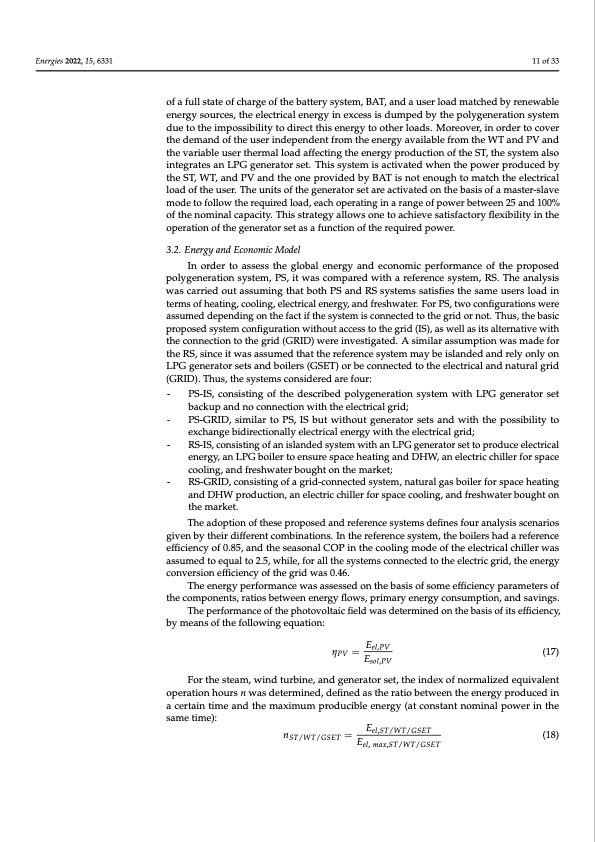
PDF Publication Title:
Text from PDF Page: 011
Energies 2022, 15, 6331 11 of 33 of a full state of charge of the battery system, BAT, and a user load matched by renewable energy sources, the electrical energy in excess is dumped by the polygeneration system due to the impossibility to direct this energy to other loads. Moreover, in order to cover the demand of the user independent from the energy available from the WT and PV and the variable user thermal load affecting the energy production of the ST, the system also integrates an LPG generator set. This system is activated when the power produced by the ST, WT, and PV and the one provided by BAT is not enough to match the electrical load of the user. The units of the generator set are activated on the basis of a master-slave mode to follow the required load, each operating in a range of power between 25 and 100% of the nominal capacity. This strategy allows one to achieve satisfactory flexibility in the operation of the generator set as a function of the required power. 3.2. Energy and Economic Model In order to assess the global energy and economic performance of the proposed polygeneration system, PS, it was compared with a reference system, RS. The analysis was carried out assuming that both PS and RS systems satisfies the same users load in terms of heating, cooling, electrical energy, and freshwater. For PS, two configurations were assumed depending on the fact if the system is connected to the grid or not. Thus, the basic proposed system configuration without access to the grid (IS), as well as its alternative with the connection to the grid (GRID) were investigated. A similar assumption was made for the RS, since it was assumed that the reference system may be islanded and rely only on LPG generator sets and boilers (GSET) or be connected to the electrical and natural grid (GRID). Thus, the systems considered are four: - PS-IS, consisting of the described polygeneration system with LPG generator set backup and no connection with the electrical grid; - PS-GRID, similar to PS, IS but without generator sets and with the possibility to exchange bidirectionally electrical energy with the electrical grid; - RS-IS, consisting of an islanded system with an LPG generator set to produce electrical energy, an LPG boiler to ensure space heating and DHW, an electric chiller for space cooling, and freshwater bought on the market; - RS-GRID, consisting of a grid-connected system, natural gas boiler for space heating and DHW production, an electric chiller for space cooling, and freshwater bought on the market. The adoption of these proposed and reference systems defines four analysis scenarios given by their different combinations. In the reference system, the boilers had a reference efficiency of 0.85, and the seasonal COP in the cooling mode of the electrical chiller was assumed to equal to 2.5, while, for all the systems connected to the electric grid, the energy conversion efficiency of the grid was 0.46. The energy performance was assessed on the basis of some efficiency parameters of the components, ratios between energy flows, primary energy consumption, and savings. The performance of the photovoltaic field was determined on the basis of its efficiency, by means of the following equation: ηPV = Eel,PV (17) Esol,PV For the steam, wind turbine, and generator set, the index of normalized equivalent operation hours n was determined, defined as the ratio between the energy produced in a certain time and the maximum producible energy (at constant nominal power in the same time): nST/WT/GSET = Eel,ST/WT/GSET (18) Eel, max,ST/WT/GSETPDF Image | Hybrid Polygeneration System Based on Biomass Wind and Solar Energy

PDF Search Title:
Hybrid Polygeneration System Based on Biomass Wind and Solar EnergyOriginal File Name Searched:
energies-15-06331-v2.pdfDIY PDF Search: Google It | Yahoo | Bing
Turbine and System Plans CAD CAM: Special for this month, any plans are $10,000 for complete Cad/Cam blueprints. License is for one build. Try before you buy a production license. More Info
Waste Heat Power Technology: Organic Rankine Cycle uses waste heat to make electricity, shaft horsepower and cooling. More Info
All Turbine and System Products: Infinity Turbine ORD systems, turbine generator sets, build plans and more to use your waste heat from 30C to 100C. More Info
CO2 Phase Change Demonstrator: CO2 goes supercritical at 30 C. This is a experimental platform which you can use to demonstrate phase change with low heat. Includes integration area for small CO2 turbine, static generator, and more. This can also be used for a GTL Gas to Liquids experimental platform. More Info
Introducing the Infinity Turbine Products Infinity Turbine develops and builds systems for making power from waste heat. It also is working on innovative strategies for storing, making, and deploying energy. More Info
Need Strategy? Use our Consulting and analyst services Infinity Turbine LLC is pleased to announce its consulting and analyst services. We have worked in the renewable energy industry as a researcher, developing sales and markets, along with may inventions and innovations. More Info
Made in USA with Global Energy Millennial Web Engine These pages were made with the Global Energy Web PDF Engine using Filemaker (Claris) software.
Sand Battery Sand and Paraffin for TES Thermo Energy Storage More Info
| CONTACT TEL: 608-238-6001 Email: greg@infinityturbine.com | RSS | AMP |